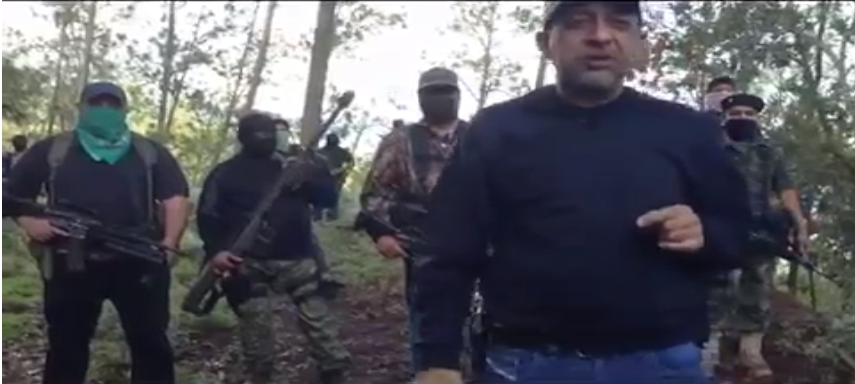If the state either abuses or fails to protect them, Mexicans look to history for solutions. Sometimes they take matters into their own hands. A year ago they did so when Mexico’s self-defence paramilitary forces reclaimed a large part of Michoacán from Los Caballeros Templarios, the country’s newest drug cartel.
Michoacán was, as historian Enrique Krauze reminds us, the site of the Mexican wars of the 19th and 20th centuries: the War of Independence, the War of Reform, the French Invasion, the Mexican Revolution and the Cristero War. Now it is the epicentre of the drug war.
Michoacán, in the country's southwest, is one of Mexico’s wealthiest and most beautiful states. It's also the most violent. Since 2010 it has been under the control of the so-called Los Caballeros Templarios (Knights Templar), the newest drug cartel formed by a splinter group of La Familia (The Family), a pseudo-religious criminal group that in 2006 forced out the Zetas and Sinaloa drug cartels.

Some sectors of the international media have wrongfully described the self-defence groups — vigilantes — as a new phenomenon in Mexico. Actually, they're nothing new. Self-defence armed groups have existed for centuries, and are responses to the abuses of the financial, political and criminal powers. They belong to the past as well as contemporary Mexican history.
Three years ago, indigenous people from Cherán, also in Michoacán, decided to battle illegal logging and drug violence by kicking out the police and running the town according to indigenous tradition. And 2014 marks the 20th anniversary of the Zapatista uprising, the self-defence indigenous movement that restored order and self-determination in Chiapas. As one Mexican writer described it, “self-defence is in the DNA of our people.”
Last year, in February 2013, the people of Michoacán said basta! – enough of the drug cartels and also enough of Mexico’s institutional inability to protect them. A year ago — when the temperature reached an average of 32 degrees in Tierra Calientes, a region that extends some areas of the states of Michoacán, Guerrero and Estado de Mexico — the self-defence movement arose once again from the annals of Mexico’s history.
Mexico’s self-defence organisations have an illustrious history. José Doroteo Arango Arámbula – better known by his pseudonym of Pancho Villa — is perhaps the embodiment of the tradition. Exhausted by the abuses of the powerful and the rein of impunity — his 14-year-old sister was raped by the owner of the ranch where they lived and worked — he took matters into his own hands. He killed the rancher and headed to the mountains where he formed a peasant self-defence organisation that would come to play a key role in the Mexican Revolution.
First with modest rifles and now with sophisticated weaponry today, self-defence organisations have recovered a large part of Michoacán from the drug cartels and have removed the local political elite and the chiefs of police, most of them corrupt and in collusion with criminals.
As Patricio Asfura-Heim and Ralph H. Espach wrote in Foreign Affairs:
"Mexico has suffered staggering levels of violence and crime during the country’s seven-year-long war against the cartels. The fighting has killed 90,000 people so far, a death toll larger, as of this writing, than that of the civil war in Syria. Homicide rates have tripled since 2007.”
Mexico’s President Enrique Peña Nieto is getting anxious. Mexico is embroiled in a three-pronged civil conflict; the state against the cartels, the cartels against other cartels, and now self-defence organisations against the cartels. A four-pronged conflict is not a far-fetched scenario, the state against the self-defence organisations in an attempt to disarm them.
In the last few months, Peña Nieto has gone on the offensive. He visited Michoacán and announced — last December — that the federal government, having struggled to defeat the cartels using corrupt local police and an inadequate military, would create an elite national police force of 10,000 officers by the end of 2014.
However, he has failed so far to domesticate the vigilantes. Peña Nieto has been forced to yield to the demands of the self-defence leadership. In a scene reminiscent of the 1974 Sam Peckinpah US cult film, Bring Me the Head of Alfredo Garcia, they have demanded the head of Servando Gómez Martínez’s, nicknamed La Tuta (the Teacher), the brutal leader of the Knights Tempar. If Peña Nieto can’t oblige, the vigilantes won’t hand over their weapons.

The success of the vigilantes so far is not insignificant. They have not only made the Templars retreat from Michoacán, but have forced the Mexican government to pour an unprecedented level of financial assistance into the state. Peña Nieto has said his government would invest the equivalent of about $3.4 billion in social and infrastructure programs for the besieged state.
Peña Nieto is also reaching back into Mexico's history to prevent an escalation of the conflict. He is following the path of two great Mexican presidents, Benito Juarez and Porfirio Díaz, who in the last decades of the 19th century incorporated the numerous self-defence organisations into the legal sphere. They became known as Guardias Rurales (Rural Guards) and became key actors in the post-revolution pacification of the country.
Despair and impunity are perhaps the two words that best explain the reappearance of self–defence groups in Mexico today. Nonetheless, in a country where every half hour somebody is murdered, and the expansion of cemeteries has become a highly lucrative business, the pacification of the country seems to be a long way off.
Donate To New Matilda
New Matilda is a small, independent media outlet. We survive through reader contributions, and never losing a lawsuit. If you got something from this article, giving something back helps us to continue speaking truth to power. Every little bit counts.



